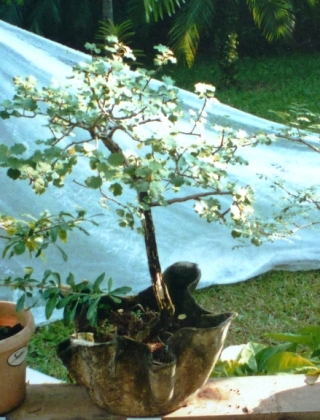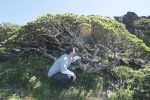Dombeya rotundifolia
+5
Francois
moyogijohn
Rob Kempinski
jrodriguez
Budi Sulistyo
9 posters
Page 1 of 2
Page 1 of 2 • 1, 2 
 Dombeya rotundifolia
Dombeya rotundifolia
Hi all,
It was around ten years ago when Dirk Everaert, a bonsai lover who had many species from Abroad had to leave Jakarta. As he could not bring his trees, he left all of them in my garden. One of thgem was a nice small round leaves tree that I liked so much.

It took a long time for me to decide to shape it, as I have only one tree of this species. And I was not able to propegate it. It bear flowers, but never it had fruits in my garden. I tried to air layer it, but I was not successful. I tried to move it in a small pot to test the durability on small container. It grew well, anyhow. I cut some branches and tried to shape it.

Later on I found a rock pot made in Indonesia. I tried to put it in the pot. Here is the shape right now.

For a long time I did not know the name of this tree. I even take the detail picture to ask advise from bonsai friends, but of no answer. Here is the detail.

I just remembered that once Dirk mentioned that it was a South African tree. But when I visited Cape town last September for a bonsai program, I did not find any bonsai from this material.
Fortunately, Dirk that I lost contact for a long time, up so sudden responded my email. He told me that it was a Dombeya rotundifolia or Wild Pear or Drolpeer in Africans.
It was around ten years ago when Dirk Everaert, a bonsai lover who had many species from Abroad had to leave Jakarta. As he could not bring his trees, he left all of them in my garden. One of thgem was a nice small round leaves tree that I liked so much.

It took a long time for me to decide to shape it, as I have only one tree of this species. And I was not able to propegate it. It bear flowers, but never it had fruits in my garden. I tried to air layer it, but I was not successful. I tried to move it in a small pot to test the durability on small container. It grew well, anyhow. I cut some branches and tried to shape it.

Later on I found a rock pot made in Indonesia. I tried to put it in the pot. Here is the shape right now.

For a long time I did not know the name of this tree. I even take the detail picture to ask advise from bonsai friends, but of no answer. Here is the detail.

I just remembered that once Dirk mentioned that it was a South African tree. But when I visited Cape town last September for a bonsai program, I did not find any bonsai from this material.
Fortunately, Dirk that I lost contact for a long time, up so sudden responded my email. He told me that it was a Dombeya rotundifolia or Wild Pear or Drolpeer in Africans.

Budi Sulistyo- Member
 Re: Dombeya rotundifolia
Re: Dombeya rotundifolia
Bagus!!! Pak Budi
Great Tree!!! Very delicate and yet so old.
Below, some more info on this species:
English common name comes from the masses of white blooms which appear before the leaves in early spring. It bears a resemblance to a true pear (Pyrus communis) in full flower. It is no relation of the pear tree, which is in the Rose family (Roseaceae) like the peach and apricot.
Like other Dombeya species the flowers remain on the tree until after the fruit capsules have formed in the centre of each flower. The petals turn brown and become dry and light. Once the fruit is ripe and falls from the tree, the petals act as wings and float it away. The wild pear grows in woodland, wooded grassland and rocky mountain slopes from Kwazulu-Natal northwards to Ethiopia.
The name Dombeya was given in honour of Joseph Dombey (1742 - 1793), a French botanist who worked in Peru and Chilé. Rotundifolia refers to the round leaves of this species.
This is a deciduous, very fast growing tree, 1 - 1.5 m per year. It may reach up to 10 m in height but is usually between 3 and 6 m. The bark is dark brown, very rough and corky on mature trees. It forms a protective, fire resistant layer around the trunk. The leaves are almost round and are covered with the minute star-like hairs, which are a character of Dombeya.
The wild pear is a lovely garden specimen, the spectacular show of scented flowers is a herald of spring. It has a single stem and a somewhat rounded crown. It is both frost and drought resistant. The flowers appear from July to September, the earlier flowering taking place in the warmer northern areas. The dried flowers can be used in flower arranging. This is a good wildlife garden tree as it attracts bees and butterflies. It is a larval food plant for the Ragged Skipper (Caprona pillaana) butterfly. The wild pear is also reportedly a good bonsai specimen, which develops the corky bark and reduced leaf size after 2 - 3 years.
The wild pear has many traditional uses as well. Strong rope fibre is made from the bark and the plant is used medicinally for various purposes, including a love potion made from the flowers. It is a useful tree on farms and nature reserves as game and stock browse from it. The wood is termite resistant and often used as fence posts. Bee farmers also appreciate the tree for the large amounts of nectar and pollen which it produces.
Your Friend,
Jose Luis
Great Tree!!! Very delicate and yet so old.
Below, some more info on this species:
English common name comes from the masses of white blooms which appear before the leaves in early spring. It bears a resemblance to a true pear (Pyrus communis) in full flower. It is no relation of the pear tree, which is in the Rose family (Roseaceae) like the peach and apricot.
Like other Dombeya species the flowers remain on the tree until after the fruit capsules have formed in the centre of each flower. The petals turn brown and become dry and light. Once the fruit is ripe and falls from the tree, the petals act as wings and float it away. The wild pear grows in woodland, wooded grassland and rocky mountain slopes from Kwazulu-Natal northwards to Ethiopia.
The name Dombeya was given in honour of Joseph Dombey (1742 - 1793), a French botanist who worked in Peru and Chilé. Rotundifolia refers to the round leaves of this species.
This is a deciduous, very fast growing tree, 1 - 1.5 m per year. It may reach up to 10 m in height but is usually between 3 and 6 m. The bark is dark brown, very rough and corky on mature trees. It forms a protective, fire resistant layer around the trunk. The leaves are almost round and are covered with the minute star-like hairs, which are a character of Dombeya.
The wild pear is a lovely garden specimen, the spectacular show of scented flowers is a herald of spring. It has a single stem and a somewhat rounded crown. It is both frost and drought resistant. The flowers appear from July to September, the earlier flowering taking place in the warmer northern areas. The dried flowers can be used in flower arranging. This is a good wildlife garden tree as it attracts bees and butterflies. It is a larval food plant for the Ragged Skipper (Caprona pillaana) butterfly. The wild pear is also reportedly a good bonsai specimen, which develops the corky bark and reduced leaf size after 2 - 3 years.
The wild pear has many traditional uses as well. Strong rope fibre is made from the bark and the plant is used medicinally for various purposes, including a love potion made from the flowers. It is a useful tree on farms and nature reserves as game and stock browse from it. The wood is termite resistant and often used as fence posts. Bee farmers also appreciate the tree for the large amounts of nectar and pollen which it produces.
Your Friend,
Jose Luis

jrodriguez- Member
 dombeya rotundifolia
dombeya rotundifolia
Budi,,Very nice tree you have..I could not see the final shape you have made with it!! good job,,i hear wild pears are good bonsai...take care john
moyogijohn- Member
 Re: Dombeya rotundifolia
Re: Dombeya rotundifolia
jrodriguez wrote:Bagus!!! Pak Budi
Great Tree!!! Very delicate and yet so old.
Below, some more info on this species:
English common name comes from the masses of white blooms which appear before the leaves in early spring. It bears a resemblance to a true pear (Pyrus communis) in full flower. It is no relation of the pear tree, which is in the Rose family (Roseaceae) like the peach and apricot.
Like other Dombeya species the flowers remain on the tree until after the fruit capsules have formed in the centre of each flower. The petals turn brown and become dry and light. Once the fruit is ripe and falls from the tree, the petals act as wings and float it away. The wild pear grows in woodland, wooded grassland and rocky mountain slopes from Kwazulu-Natal northwards to Ethiopia.
The name Dombeya was given in honour of Joseph Dombey (1742 - 1793), a French botanist who worked in Peru and Chilé. Rotundifolia refers to the round leaves of this species.
This is a deciduous, very fast growing tree, 1 - 1.5 m per year. It may reach up to 10 m in height but is usually between 3 and 6 m. The bark is dark brown, very rough and corky on mature trees. It forms a protective, fire resistant layer around the trunk. The leaves are almost round and are covered with the minute star-like hairs, which are a character of Dombeya.
The wild pear is a lovely garden specimen, the spectacular show of scented flowers is a herald of spring. It has a single stem and a somewhat rounded crown. It is both frost and drought resistant. The flowers appear from July to September, the earlier flowering taking place in the warmer northern areas. The dried flowers can be used in flower arranging. This is a good wildlife garden tree as it attracts bees and butterflies. It is a larval food plant for the Ragged Skipper (Caprona pillaana) butterfly. The wild pear is also reportedly a good bonsai specimen, which develops the corky bark and reduced leaf size after 2 - 3 years.
The wild pear has many traditional uses as well. Strong rope fibre is made from the bark and the plant is used medicinally for various purposes, including a love potion made from the flowers. It is a useful tree on farms and nature reserves as game and stock browse from it. The wood is termite resistant and often used as fence posts. Bee farmers also appreciate the tree for the large amounts of nectar and pollen which it produces.
Your Friend,
Jose Luis
Jose Luis,
You really have written good information on the tree. Thanks a lot.
In fact I would like to see some more Dombeya rotundifolia bonsai. Does any body have this specimen?
Your friend,
Budi
Rob and John,
Thanks for the good comments.
Budi

Budi Sulistyo- Member
 Re: Dombeya rotundifolia
Re: Dombeya rotundifolia
Hi.. I hope you are still a member
Im new to the forum and started reading the entire forum from page one and Im on page 77 of 116!
Anyway, Im from South africa and this tree does not grow in Cape town but in the North, near Pretoria, they grow around my house and they dont like intense fire, slow growing but will resprout to broostick thickness in three to four years
You get two types, whit flowers and light pink- but Ive only seen the pink once, but both smell very sweet
Ive also never seen them fruit but the seedlings sometimes just seem to appear a few metres from the tree
Ive only seen one bonsai from this and itwas made just for the species, but ive heard that its not an easy spe ies to work with. I went and bought one though
When summer starts in September I will plant it out
Do you have any advice on this tree- you succeeded excellently
Im new to the forum and started reading the entire forum from page one and Im on page 77 of 116!
Anyway, Im from South africa and this tree does not grow in Cape town but in the North, near Pretoria, they grow around my house and they dont like intense fire, slow growing but will resprout to broostick thickness in three to four years
You get two types, whit flowers and light pink- but Ive only seen the pink once, but both smell very sweet
Ive also never seen them fruit but the seedlings sometimes just seem to appear a few metres from the tree
Ive only seen one bonsai from this and itwas made just for the species, but ive heard that its not an easy spe ies to work with. I went and bought one though
When summer starts in September I will plant it out
Do you have any advice on this tree- you succeeded excellently

Francois- Member
 Re: Dombeya rotundifolia
Re: Dombeya rotundifolia
I was not even a member when this conversation started..
Budi the reason why I think that Dombeya is not used as bonsai is pure ignorance..
Firstly it has a very huge leave, so one disgards the idea of bonsai.
Secondly its very sparse.
As a landscaping subject people are very fussy. Its a quick grower and very showy flowers, but the dead flowers stays on the bush, so later its has more dead flowers on it that fresh ones , and this makes the tree look rather messy. And this puts people off. Very strange.
Yours is looking stunning indeed, and I will definitely follow suit....
Prunus welcome and thank you for reviving this.
Dombeya is quite a vast family of about 240 species...and some do occur in the Cape, not rotundifolia though.
Love and light
Budi the reason why I think that Dombeya is not used as bonsai is pure ignorance..
Firstly it has a very huge leave, so one disgards the idea of bonsai.
Secondly its very sparse.
As a landscaping subject people are very fussy. Its a quick grower and very showy flowers, but the dead flowers stays on the bush, so later its has more dead flowers on it that fresh ones , and this makes the tree look rather messy. And this puts people off. Very strange.
Yours is looking stunning indeed, and I will definitely follow suit....
Prunus welcome and thank you for reviving this.
Dombeya is quite a vast family of about 240 species...and some do occur in the Cape, not rotundifolia though.
Love and light

Andre Beaurain- Member
 Re: Dombeya rotundifolia
Re: Dombeya rotundifolia
D. rotundifolia is slow, I didnt know there were other species but thats exactly why its not used I think, I bought a 2m high tree, thick as a cooldrink can and after chopping it has taken 3/4 weeks for it to put out two new leaves on a low bud it had, and make a new bud higher up. Four weeks.
I will try and layer a tree nearby in spring but I dont expect much, especially after seeing this post
I will try and layer a tree nearby in spring but I dont expect much, especially after seeing this post

Francois- Member
 Re: Dombeya rotundifolia
Re: Dombeya rotundifolia
I have one future bonsai in the ground fattening...it has gone from 2-3cm to 6cm trunk diameter in one year...I chopped it back a week ago...I never had problem propagating it from hard wood cuttings...

Neli- Member
 Re: Dombeya rotundifolia
Re: Dombeya rotundifolia
Neli wrote:I have one future bonsai in the ground fattening...it has gone from 2-3cm to 6cm trunk diameter in one year...I chopped it back a week ago...I never had problem propagating it from hard wood cuttings...
How simple it is, Neli. What is the weather condition in your country?
Budi

Budi Sulistyo- Member
 Re: Dombeya rotundifolia
Re: Dombeya rotundifolia
Andre Beaurain wrote:I was not even a member when this conversation started..
Budi the reason why I think that Dombeya is not used as bonsai is pure ignorance..
Firstly it has a very huge leave, so one disgards the idea of bonsai.
Secondly its very sparse.
As a landscaping subject people are very fussy. Its a quick grower and very showy flowers, but the dead flowers stays on the bush, so later its has more dead flowers on it that fresh ones , and this makes the tree look rather messy. And this puts people off. Very strange.
Yours is looking stunning indeed, and I will definitely follow suit....
Prunus welcome and thank you for reviving this.
Dombeya is quite a vast family of about 240 species...and some do occur in the Cape, not rotundifolia though.
Love and light
Hi Andre,
The leaves are very small. Probably they are not of the same sub species.
Budi

Budi Sulistyo- Member
 Re: Dombeya rotundifolia
Re: Dombeya rotundifolia
\"Neli wrote: it has gone from 2-3cm to 6cm trunk diameter in one year...I chopped it back a week ago...I never had problem propagating it from hard wood cuttings...
What is your fertilizing regime and or soil conditions Neli? Im addicted to anything with roundish leaves, Apricots, wild Pear, apples... and I feel an obsession coming on

Last edited by Francois on Tue Jun 17, 2014 5:44 pm; edited 1 time in total (Reason for editing : quote nor right)

Francois- Member
 Re: Dombeya rotundifolia
Re: Dombeya rotundifolia
Body I shall go and get pictures in the garden for you. I also took cuttings and planted them...but have done it before many times (commercial nursery) I find it easy...I have plants that are hard to root but this one is easy. Climate is like this.Budi Sulistyo wrote:Neli wrote:I have one future bonsai in the ground fattening...it has gone from 2-3cm to 6cm trunk diameter in one year...I chopped it back a week ago...I never had problem propagating it from hard wood cuttings...
How simple it is, Neli. What is the weather condition in your country?
Budi

I take big hard wood cuttings, no rooting hormone, planted in washed sieved river sand. I shall also look for a picture from last year when I bought it for you to see how much it has grown. I have two types...The one like yours and the one with the pink flowers.
Going to check the cuttings also if they are coming up...but one week is too soon and it is winter here now. I actually took them at the wrong time of the year. I just wanted to chop it (instead of scratching someones eyes...he he he) so decided to put the cuttings in...just a few.

Neli- Member
 Re: Dombeya rotundifolia
Re: Dombeya rotundifolia
Darling I am in Africa in a country that has very moderate climate...no high temperatures and no lows too...trees grow all year round. I had ficus sur, grow to 20cm in the ground from 3-4cm trunk...in 18 month...I know it is hard to believe...but it is the truth. The SA forum is closed now, or you would have seen a progression of how things grow here.Francois wrote:\"Neli wrote: it has gone from 2-3cm to 6cm trunk diameter in one year...I chopped it back a week ago...I never had problem propagating it from hard wood cuttings...
What is your fertilizing regime and or soil conditions Neli? Im addicted to anything with roundish leaves, Apricots, wild Pear, apples... and I feel an obsession coming on
I fertilize every thing every two weeks...In the ground I alternate cow manure and chemical fertilizer...everything is watered as soon as it is dry.
I take very often truncheon cuttings:



This are prunus cuttings I took a month ago:


Neli- Member
 Re: Dombeya rotundifolia
Re: Dombeya rotundifolia
Budi Sulistyo wrote:
Hi Andre,
The leaves are very small. Probably they are not of the same sub species.
Budi
No on the contrary, I think its just that the leaves reduce very very well.
Love and light

Andre Beaurain- Member
 Re: Dombeya rotundifolia
Re: Dombeya rotundifolia
Andre,
The white flowering dombeya I have has much smaller leaves than the pink one.
The white flowering dombeya I have has much smaller leaves than the pink one.

Neli- Member
 Re: Dombeya rotundifolia
Re: Dombeya rotundifolia
Here Budi: Took some pictures for you. The cuttings have new shoots even trying to flower, but I doubt if they are rooted.
Forgot to chop pne branch and it is 4m long and found a flower and buds on it...

My gardeners hand for size...I think it is more than what I stated before must be like 8cm+diameter.

Can you see the branch my gardener is holding? Twice his height.


Found one flower but a bad picture
The cuttings from it:



Forgot to chop pne branch and it is 4m long and found a flower and buds on it...

My gardeners hand for size...I think it is more than what I stated before must be like 8cm+diameter.

Can you see the branch my gardener is holding? Twice his height.


Found one flower but a bad picture
The cuttings from it:




Neli- Member
 Re: Dombeya rotundifolia
Re: Dombeya rotundifolia
Neli wrote:Andre,
The white flowering dombeya I have has much smaller leaves than the pink one.
NO really!
hihihihihihihihiii O please Neli what can you teach me about plants? Silly Girl.

I still love you though.

Andre Beaurain- Member
 Re: Dombeya rotundifolia
Re: Dombeya rotundifolia
Southern Africa here
Thats amazing... I use cow and chicken manure almost exclusively
I let the cow cakes soak like a tea and throw that onto my trees until its finished (20L) bucket
I remember that F. Religiosa branch's thread on the SA forum .... that is amazing, even if it is for a ficus
Thats amazing... I use cow and chicken manure almost exclusively
I let the cow cakes soak like a tea and throw that onto my trees until its finished (20L) bucket
I remember that F. Religiosa branch's thread on the SA forum .... that is amazing, even if it is for a ficus

Francois- Member
 Re: Dombeya rotundifolia
Re: Dombeya rotundifolia
Nothing wrong with manure for plants in the ground...Just that I really force my plants to grow...so I add some acid fertilizer since My water PH is 8.5.+. I use the tea from the manure (I make it in big drums) on my normal bonsai, and add it to the water I water them with...I add acid also in the water. I rotate that with all kinds of fertilizers...but some acid some soluble, for spraying on the plants...but I add in the water for watering. I dont ever put any water on the leaves of my trees...unless rain. My water is so hard they will all be white if I do, and I dont like that.Francois wrote:Southern Africa here
Thats amazing... I use cow and chicken manure almost exclusively
I let the cow cakes soak like a tea and throw that onto my trees until its finished (20L) bucket
I remember that F. Religiosa branch's thread on the SA forum .... that is amazing, even if it is for a ficus
The 20cm diameter fig cuttings have 15+ cm branches now, so I suspect they are rooted.

Neli- Member
 Re: Dombeya rotundifolia
Re: Dombeya rotundifolia
Just googled all the Dombeya species, I think I still like Rotundifolia better hahaha
Very rare in pink but I found one pic, Its almost more beautiful )
)
?i=3&u=18902868] [/url]
[/url]
Very rare in pink but I found one pic, Its almost more beautiful
?i=3&u=18902868]
 [/url]
[/url]
Francois- Member
 Re: Dombeya rotundifolia
Re: Dombeya rotundifolia
Did you know it is indigenous to Zambia? I got mine from the indigenous nursery.

Neli- Member
 Re: Dombeya rotundifolia
Re: Dombeya rotundifolia
Did not know it went up that far, its indigenous to SA, kenya and Zim as well

Francois- Member
Page 1 of 2 • 1, 2 
Page 1 of 2
Permissions in this forum:
You cannot reply to topics in this forum






